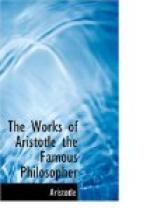When a woman is pregnant with two children, they rarely present to the birth together, the one being generally more forward than the other; and that is the reason that but one is felt, and that many times the midwife knows not that there are twins until the first is born, and that she is going to fetch away the afterbirth. In the first chapter, wherein I treated of natural labour, I have showed how a woman should be delivered of twins, presenting themselves both right; and before I close the chapter of unnatural labour, it only remains that I show what ought to be done when they either both come wrong or one of them only, as for the most part it happens; the first generally coming right, and the second with the feet forward, or in some worse posture. In such a case, the birth of the first must be hastened as much as possible and to make way for the second, which is best brought away by the feet, without endeavouring to place it right, because it has been, as well as the mother, already tired and weakened by the birth of the first, and there would be greater danger to its death, than likelihood of its coming out of the womb that way.
But if, when the first is born naturally, the second should likewise offer its head to the birth, it would then be best to leave nature to finish what she has so well begun, and if nature should be too slow in her work, some of those things mentioned in the fourth chapter to accelerate the birth, may be properly enough applied, and if, after that, the second birth should be delayed, let a manual operation be delayed no longer, but the woman being properly placed, as has been before directed, let the operator direct his hand gently into the womb to find the feet, and so draw forth the second child, which will be the more easily effected, because there is a way made sufficiently by the birth of the first; and if the waters of the second child be not broke, as it often happens, yet, intending to bring it by its feet, he need not scruple to break the membranes with his fingers; for though, when the birth of a child is left to the operation of nature, it is necessary that the waters should break of themselves, yet when the child is brought out of the womb by art, there is no danger in breaking them, nay, on the contrary it becomes necessary; for without the waters are broken, it will be almost impossible to turn the child.
But herein principally lies the care of the operator, that he be not deceived, when either the hands or feet of both children offer themselves together to the birth; in this case he ought well to consider the operation, of whether they be not joined together, or any way monstrous, and which part belongs to one child and which to the other; so that they may be fetched one after the other, and not both together, as may be, if it were not duly considered, taking the right foot of one and the left of the other, and so drawing them together, as if they both belonged to one body, because there is a left and a right, by which




